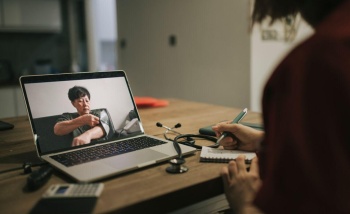
How can digital help close the cancer care gap?
As we approach World Cancer Day on 4 February, we highlight some of the key inequities that exist and the ways in which digital tools and technologies can help overcome barriers to health access and close the cancer care gap.
- Inspiration
- Healthcare
- World Cancer Day
There have been huge advancements in cancer prevention, diagnosis and treatment in recent years, with headlines regularly citing revolutionary new treatments and record-high survival rates.
But, the story is not the same for everyone. There are huge disparities in the quality of care, treatment, and survival rates across different groups. Income, education, location and discrimination based on ethnicity, gender, sexual orientation, immigration status, age, disability and lifestyle are just a few of the factors that can negatively affect care and cause a disproportionate burden from cancer.
A recent report produced by Cancer Research UK discovered that over 30,000 extra cases of cancer in the UK each year can be attributed to socio and financial deprivation, and survival is worse for the most deprived groups.
So, what can be done to address this?
As we approach World Cancer Day on 4 February, we take a look at some of the ways in which digital tools and technologies can help overcome barriers to health access and close the cancer care gap.
Virtual appointments
Replacing face-to-face appointments with virtual ones, where possible, can save cancer patients significant amounts of money and time spent travelling to and from appointments. For patients from disadvantaged socio-economic backgrounds who may already be suffering due to lost earnings whilst unwell, reducing the financial burden of treatment wherever possible is crucial.
There also are notable differences in cancer-related outcomes for rural and nonrural patients, even in high-income settings. Through the increased prevalence of virtual appointments, this inequality can be somewhat reduced by connecting patients in rural environments with specialist oncologists virtually, regardless of location.
See a recent article we published on the social benefits of telehealth here.
Access to low-cost support services
It’s important to remember that there is more to cancer care than just the clinical side — things such as finance, mental health, and childcare will be impacted. In recent years, many apps have emerged that focus on offering a holistic range of support services for cancer patients.
Untire is an app for patients and cancer survivors who are suffering from cancer-related fatigue. Developed by psychologists and based on Cognitive Behavioural Therapy (CBT) and Mindfulness-based CBT (MCBT), it aims to reduce fatigue by engaging users mentally and physically. The app is completely free of charge, removing the barriers to often costly professional mental health support, and has been reporting significant results amongst users.
Other examples include Alike, a peer-support app which aims to combat isolation and loneliness throughout treatment by allowing patients to share their experiences and connect with one another, and Create to Heal, which uses guided meditations, music, art and animation to help reduce stress.
Improving access to best practice information for HCPs
As well as supporting patients, digital means can improve access to the latest information and advice for HCPs in underserved communities around the world. No matter the location or circumstances under which they are treating patients, best practice information and guidance can be made available to HCPs at the click of a button to support them in many aspects of patient care and share directly with patients as appropriate — communication guidelines; digital patient resources; toolkits; advice on navigating complex healthcare systems; and more.
On the ABC Global Alliance Website, for example, you’ll find a searchable list of all the current initiatives and best practice documents. Specific initiatives include the Dandelion Toolkit, a visual-led discussion guide to improve communication between physicians and newly-diagnosed patients, and SATORI (II), a holistic wellness programme for women in India with recurring breast cancer.
Building awareness through highly targeted digital marketing
Using digital channels healthcare organisations, charities or public health bodies can create highly-targeted awareness campaigns to reach groups that are being disproportionately affected by types of cancer.
For white women in the US, the five-year survival rate for cervical cancer is 71%. For black women, the rate is just 58%. Using data that social media and tech companies already hold around peoples’ demographics, organisations can target, for example, “women of colour over the age of 55” with information about local cervical cancer screening services, or an awareness campaign around early symptoms.
These types of focused campaigns could be replicated to target almost any specific group to help address the imbalance in their cancer outcomes.

Helping patients navigate treatment and care
In lower middle-income countries, or amongst other disadvantaged groups with lower levels of education, some patients may not have the means to understand what is available to them in terms of identifying symptoms, navigating treatment and seeking appropriate care and support. Treatment adherence can also be lower with patients struggling to keep on top of complex treatment plans and becoming overwhelmed without additional support.
New digital health tools are seeking to address this by offering simple, patient-friendly ways for patients to access information and engage with services.
In Nigeria, where, due to a short supply of clinicians, 1 oncologist treats an average of 1250 patients, the Sebeccly Cancer Care and Support Centre are helping patients navigate and access earlier cancer diagnosis and treatment with the launch of the digital tool Oncopadi. Through the platform, patients can consult a specialist oncologist via a video or voice consultation, and access expert opinions on diagnoses and treatment options. It also provides accurate information, coping tools and resources that help reduce the cost and complexity of care.
In the UK, Macmillan Cancer Support has recently announced a partnership with Careology, a digital care platform designed to help patients feel safe and well-equipped to manage their own cancer treatment. It will connect 3 million patients with friends, family and healthcare teams, and also allows them to monitor and share key health metrics such as symptoms, side effects and medication adherence.
Building trust
A lack of trust between marginalised communities and healthcare services can lead to later diagnoses, and in turn, lower survival rates or treatment outcomes.
By improving the access that patients have to their own data, using electronic records or other digital means, patients become better informed and engaged and more able to self-manage. This increased transparency can improve trust between patients and healthcare providers.
The BELONG Beating Cancer app is the world’s largest anonymous social network for people with cancer and their carers to interact with other patients to offer peer-to-peer support and share first-hand experiences. The anonymity of the app encourages people from all groups in society to engage with the patient community without fear of discrimination of any kind.
Inclusive and accessible digital patient information
In many cases, information about cancer treatment and disease understanding that is handed out by HCPs at early-stage appointments is still provided physically in the form of leaflets or flyers.
By digitising this information in the form of a web page, app, or similar, it can much more easily be replicated in formats that work for all patient groups — regardless of first language, visual impairment, etc. Considering the crucial nature of the information included within these materials, this is especially important.
You can translate information into multiple languages, allowing the patient to select from options to suit them or add simple functionality to increase text sizes or colour to ensure the contents are accessible. Patients that rely on screen readers will also be able to process the information — removing the risk of an HCP not having an up-to-date braille copy of a leaflet to hand.
Our work within Oncology
We’re currently proud to be working with Oncology teams at a top global pharma organisation on digital projects that aim to address inequities in cancer care and widen access.
One of these projects involves the development of a website aimed at providing patients and carers with easy-to-find information on cancer types and how to manage living with cancer. We’re also working on the branding for an initiative aimed at bringing inequities to the forefront and educating HCPs to make the invisible patient visible.
A collective venture.
When embraced as part of a joined-up global effort amongst both individuals and organisations digital tools have the potential to make big positive steps towards narrowing the cancer care gap. It’s important to remember that people will have varying levels of comfort with digital technology, so a seamless, intuitive customer experience that puts the needs of the user first is crucial.
We’re excited to see how new solutions will impact the experiences of all patients in the coming years. Read more about the World Cancer Day ‘Closing the Care Gap’ initiative and how you can help spread the word or make a donation here.
Want to know more about digital healthcare?

A change in pharma mindset for a positive digital future
- Pharmaceutical
- Strategy

The case for digitising your patient resources
- Healthcare
- Pharmaceutical
- Customer Experience